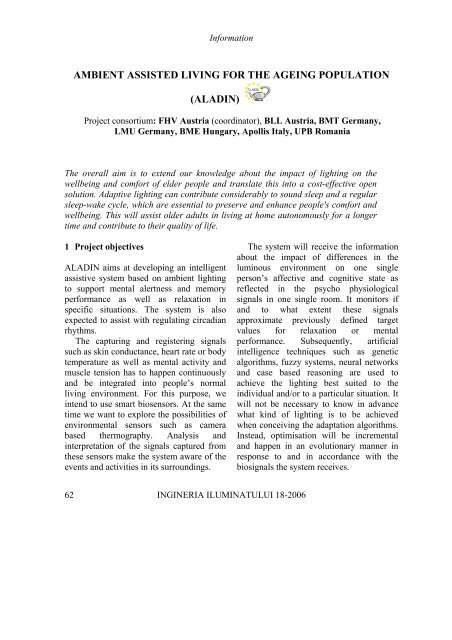This issue is sponsored by the Philips Romania, Lighting Division
This issue is sponsored by the Philips Romania, Lighting Division
This issue is sponsored by the Philips Romania, Lighting Division
Create successful ePaper yourself
Turn your PDF publications into a flip-book with our unique Google optimized e-Paper software.
Information<br />
AMBIENT ASSISTED LIVING FOR THE AGEING POPULATION<br />
(ALADIN)<br />
Project consortium: FHV Austria (coordinator), BLL Austria, BMT Germany,<br />
LMU Germany, BME Hungary, Apoll<strong>is</strong> Italy, UPB <strong>Romania</strong><br />
The overall aim <strong>is</strong> to extend our knowledge about <strong>the</strong> impact of lighting on <strong>the</strong><br />
wellbeing and comfort of elder people and translate th<strong>is</strong> into a cost-effective open<br />
solution. Adaptive lighting can contribute considerably to sound sleep and a regular<br />
sleep-wake cycle, which are essential to preserve and enhance people's comfort and<br />
wellbeing. <strong>Th<strong>is</strong></strong> will ass<strong>is</strong>t older adults in living at home autonomously for a longer<br />
time and contribute to <strong>the</strong>ir quality of life.<br />
1 Project objectives<br />
ALADIN aims at developing an intelligent<br />
ass<strong>is</strong>tive system based on ambient lighting<br />
to support mental alertness and memory<br />
performance as well as relaxation in<br />
specific situations. The system <strong>is</strong> also<br />
expected to ass<strong>is</strong>t with regulating circadian<br />
rhythms.<br />
The capturing and reg<strong>is</strong>tering signals<br />
such as skin conductance, heart rate or body<br />
temperature as well as mental activity and<br />
muscle tension has to happen continuously<br />
and be integrated into people’s normal<br />
living environment. For th<strong>is</strong> purpose, we<br />
intend to use smart biosensors. At <strong>the</strong> same<br />
time we want to explore <strong>the</strong> possibilities of<br />
environmental sensors such as camera<br />
based <strong>the</strong>rmography. Analys<strong>is</strong> and<br />
interpretation of <strong>the</strong> signals captured from<br />
<strong>the</strong>se sensors make <strong>the</strong> system aware of <strong>the</strong><br />
events and activities in its surroundings.<br />
62<br />
INGINERIA ILUMINATULUI 18-2006<br />
The system will receive <strong>the</strong> information<br />
about <strong>the</strong> impact of differences in <strong>the</strong><br />
luminous environment on one single<br />
person’s affective and cognitive state as<br />
reflected in <strong>the</strong> psycho physiological<br />
signals in one single room. It monitors if<br />
and to what extent <strong>the</strong>se signals<br />
approximate previously defined target<br />
values for relaxation or mental<br />
performance. Subsequently, artificial<br />
intelligence techniques such as genetic<br />
algorithms, fuzzy systems, neural networks<br />
and case based reasoning are used to<br />
achieve <strong>the</strong> lighting best suited to <strong>the</strong><br />
individual and/or to a particular situation. It<br />
will not be necessary to know in advance<br />
what kind of lighting <strong>is</strong> to be achieved<br />
when conceiving <strong>the</strong> adaptation algorithms.<br />
Instead, optim<strong>is</strong>ation will be incremental<br />
and happen in an evolutionary manner in<br />
response to and in accordance with <strong>the</strong><br />
biosignals <strong>the</strong> system receives.
















